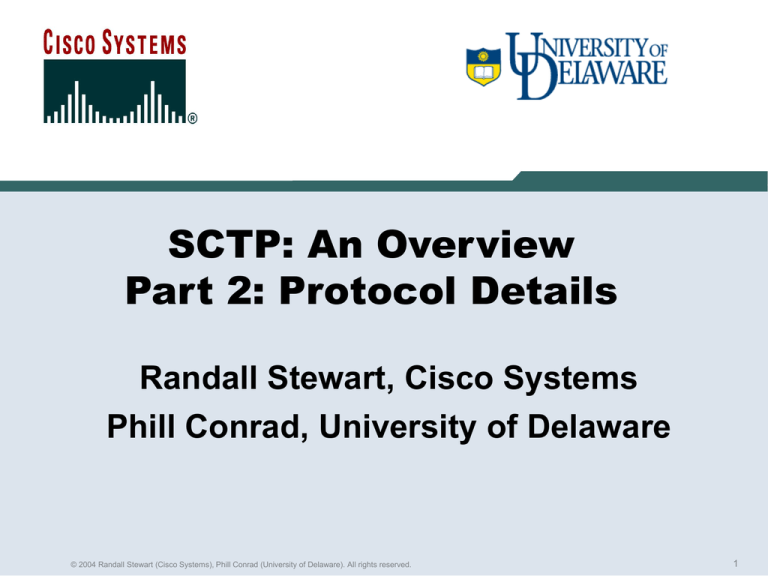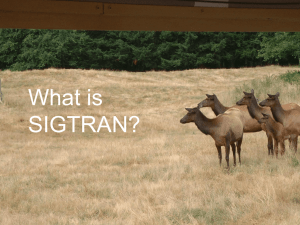
SCTP: An Overview
Part 2: Protocol Details
Randall Stewart, Cisco Systems
Phill Conrad, University of Delaware
© 2004 Randall Stewart (Cisco Systems), Phill Conrad (University of Delaware). All rights reserved.
1
Outline
10h00- intro
11h00
overview of SCTP
Randy
Phill
What is SCTP? What are the major features?
11h15- SCTP details
12h15
Randy
13h15- details of sockets API (Randy)
14h15
open Q and A
Phill or
Randy
Both
SCTP Tutorial, Ottawa 7/2004
© 2004 Randall Stewart (Cisco Systems), Phill Conrad (University of Delaware). All rights reserved.
2
Now, Randy with some details...
We are now engaging the hyperdrive...
• packet format: common header, chunks, etc.
• connection establishment
(in SCTP-speak, association establishment)
Four way handshake, State diagram
• data exchange
Streams, Ordered and Unordered Data
Reliable and Unreliable data, Timed Reliability (PR-SCTP)
• failure detection and recovery
multi-homing
heartbeats
SCTP Tutorial, Ottawa 7/2004
© 2004 Randall Stewart (Cisco Systems), Phill Conrad (University of Delaware). All rights reserved.
3
Bits and Bytes:
SCTP "on the wire"
SCTP Tutorial, Ottawa 7/2004
© 2004 Randall Stewart (Cisco Systems), Phill Conrad (University of Delaware). All rights reserved.
4
Bits, Bytes, and Chunks
• We will now turn our attention to some of the on-thewire bits and bytes of SCTP
• An SCTP packet has a common header that appears
in each packet, followed by one or more chunks
• SCTP chunks use a self-describing Tag-LengthValue (TLV) format
• Note: all figures used are always 32-bits wide
SCTP Tutorial, Ottawa 7/2004
© 2004 Randall Stewart (Cisco Systems), Phill Conrad (University of Delaware). All rights reserved.
5
Whole SCTP packet "on the wire"
Datalink Header
(e.g. Ethernet, 802.11, PPP)
IP Header
SCTP Common Header
Chunk 1
...
one or
more "chunks"
The SCTP
"packet"
Chunk N
Datalink Trailer
(e.g. Ethernet, 802.11, PPP)
SCTP Tutorial, Ottawa 7/2004
© 2004 Randall Stewart (Cisco Systems), Phill Conrad (University of Delaware). All rights reserved.
6
SCTP Common Header
Source Port
Destination Port
Verification Tag
CRC-32c Checksum
• Source and Destination Port: 16-bit port values
• Verification Tag: 32-bit random value selected by each endpoint in an
association during setup
Discriminates between two successive associations
Protection mechanism against blind attackers
• CRC32c Checksum: 32-bit CRC covering the entire SCTP packet
(SCTP common header and all chunks)
Note that RFC 3309 (CRC32c) supercedes the Adler-32 checksum defined
in RFC 2960 (SCTP)
SCTP Tutorial, Ottawa 7/2004 © 2004 Randall Stewart (Cisco Systems), Phill Conrad (University of Delaware). All rights reserved.
7
SCTP chunk header
Every chunk has a TLV form: Type (with flags), Length, then Value
The "generic" format of each chunk:
Chunk Type
Chunk Flags
Chunk Length
Chunk Data
• Chunk Type: 8-bit value indicating the type of chunk
• Chunk Flags: 8-bit flags, defined on per chunk type basis
• Chunk Length: 16-bit length in bytes, including the chunk
type, chunk flags, and chunk length fields.
Note that chunks are padded to 32-bit boundaries within an SCTP
packet. Any padding bytes (0x00) used are NOT included in the
chunk length
SCTP Tutorial, Ottawa 7/2004
© 2004 Randall Stewart (Cisco Systems), Phill Conrad (University of Delaware). All rights reserved.
8
Chunk Types
Chunk Type
Chunk Flags
Chunk Length
Chunk Data
• There are 20 chunk types currently defined in SCTP
(including both extensions in RFCs and those still in Internet Drafts):
(1) DATA (0x00)
(2) INITIATION [INIT] (0x01)
(3) INITIATION-ACKNOWLEDGMENT [INIT-ACK] (0x02)
(4) SELECTIVE-ACKNOWLEDGMENT [SACK] (0x03)
(5) HEARTBEAT (0x04)
... etc...
SCTP Tutorial, Ottawa 7/2004
© 2004 Randall Stewart (Cisco Systems), Phill Conrad (University of Delaware). All rights reserved.
9
Complete List of Chunk Types
RFC2960
(1) DATA (0x00)
(2) INIT (0x01)
(3) INIT-ACK (0x02)
(4) SACK [SELECTIVE-ACKNOWLEDGMENT] (0x03)
(5) HEARTBEAT (0x04)
(6) HEARTBEAT-ACK (0x05)
(7) ABORT (0x06)
(8) SHUTDOWN (0x07)
(9) SHUTDOWN-ACK (0x08)
(10 ERROR [OPERATIONAL-ERROR] (0x09)
(11) COOKIE-ECHO (0x0A)
(12) COOKIE-ACK (0x0B)
(13) ECNE [EXPLICIT CONGESTION NOTIFICATION
ECHO] (0x0C)
(14) CWR [CONGESTION WINDOW REDUCE] (0x0D)
(15) SHUTDOWN-COMPLETE (0x0E)
SCTP Tutorial, Ottawa 7/2004
PR-SCTP - RFC 3758
(16) FORWARD-TSN (0xC0)
ADD-IP draft
(17) ASCONF (0xC1)
[ADDRESS-CONFIGURATION]
(18) ASCONF-ACK (0x80)
Packet-Drop draft
(19) PKT-DROP (0x81)
[SCTP-PACKET-DROP-REPORT]
Authentication draft
(20) AUTH [AUTHENTICATION] (0x82) –
about to undergo drastic changes;
may add 2-3 chunks.
© 2004 Randall Stewart (Cisco Systems), Phill Conrad (University of Delaware). All rights reserved.
10
General Chunk Processing
• In any SCTP packet, control chunks always come
before DATA chunks
• Some chunks must be singletons: INIT or INIT-ACK
• Chunk type number assignments are not linear,
because...
• Chunk type upper two bits have specific meanings
used for processing unrecognized chunks
00xxxxxx => silently drop
01xxxxxx => send an ERROR chunk in reply
In both cases, remainder of the packet is ignored
10xxxxxx => Skip to next chunk
11xxxxxx => Skip to next chunk and send an ERROR chunk
SCTP Tutorial, Ottawa 7/2004
© 2004 Randall Stewart (Cisco Systems), Phill Conrad (University of Delaware). All rights reserved.
11
Pop Quiz
• To see if you are paying attention:
Assume you have an SCTP implementation that
understands NONE of the extensions mentioned earlier.
• What will the implementation do with:
- FORWARD-TSN (0xC0)
- ASCONF (0xC1)
- ASCONF-ACK (0x80)
- PKT-DROP (0x81)
- AUTHENTICATION (0x82)
SCTP Tutorial, Ottawa 7/2004
© 2004 Randall Stewart (Cisco Systems), Phill Conrad (University of Delaware). All rights reserved.
12
Connection
Establishment
(actually, "association" establishment...)
SCTP Tutorial, Ottawa 7/2004
© 2004 Randall Stewart (Cisco Systems), Phill Conrad (University of Delaware). All rights reserved.
13
SCTP is connection-oriented
• Like TCP, SCTP is connection-oriented
– i.e. three phases: setup, communicate, teardown
– requires a setup procedure to establish the communication relationship between
two parties,
– maintains state at the endpoints
• Note: connection-oriented DOES NOT NECESSARILY imply reliable,
– SCTP is always connection oriented, but ...
– SCTP can be configured to be reliable, unreliable or partially reliable
• To establish this state, both sides go through a specific set of exchanges
TCP uses a 3-way handshake (SYN, SYN/ACK, ACK)
SCTP uses a 4-way handshake (INIT, INIT-ACK, COOKIE-ECHO, COOKIE-ACK)
SCTP Tutorial, Ottawa 7/2004
© 2004 Randall Stewart (Cisco Systems), Phill Conrad (University of Delaware). All rights reserved.
14
The a-word: association
• In TCP, the communication relationship between two
endpoints is called a connection
Socket pair: { <Local IP addr, port>, <Remote IP addr, port> }
e.g. { <10.1.61.11, 2223>, <161.10.8.221, 80> }
• In SCTP, we would call this an association
• An SCTP association can be represented as a pair of
SCTP endpoints:
assoc = { [10.1.61.11 : 2223],
[161.10.8.221, 120.1.1.5 : 80] }
Note: second endpoint has two IP addresses
word "association" emphasizes that the two endpoints are "associated"
rather than that two IP-addresses (interfaces) are "connected"
SCTP Tutorial, Ottawa 7/2004
© 2004 Randall Stewart (Cisco Systems), Phill Conrad (University of Delaware). All rights reserved.
15
Associations and Endpoints
• An SCTP endpoint is a port number on a specific host
• An SCTP endpoint may have multiple associations
• Only one association may be established between any
two SCTP endpoints
SCTP Tutorial, Ottawa 7/2004
© 2004 Randall Stewart (Cisco Systems), Phill Conrad (University of Delaware). All rights reserved.
16
Setting Up an Association
Endpoint A
Endpoint Z
INIT
INIT-ACK
Association
Is Up
COOKIE-ECHO
*
*
Association
Is Up
COOKIE-ACK
* -- User data can be attached
SCTP Tutorial, Ottawa 7/2004
© 2004 Randall Stewart (Cisco Systems), Phill Conrad (University of Delaware). All rights reserved.
17
SCTP state diagram
COOKIE_WAIT
CLOSED
COOKIE_ECHOED
ESTABLISHED
SHUTDOWNPENDING
SHUTDOWNPENDING
SHUTDOWNSENT
SHUTDOWNACK-SENT
CLOSED
Page 32 of the SCTP book
SCTP Tutorial, Ottawa 7/2004
© 2004 Randall Stewart (Cisco Systems), Phill Conrad (University of Delaware). All rights reserved.
18
Data Transfer
Ordinary transfer
Streams
Unordered
PR-SCTP
SCTP Tutorial, Ottawa 7/2004
© 2004 Randall Stewart (Cisco Systems), Phill Conrad (University of Delaware). All rights reserved.
19
Data Transfer Basics
• We now shift our attention to normal data transfer.
• Data transfer happens in the ESTABLISHED,
SHUTDOWN-PENDING, SHUTDOWN-SENT and
SHUTDOWN-RECEIVED states.
• Note that even though the COOKIE-ECHO and
COOKIE-ACK can optionally bundle DATA, we are in
the ESTABLISHED state by the time the DATA is
processed.
SCTP Tutorial, Ottawa 7/2004
© 2004 Randall Stewart (Cisco Systems), Phill Conrad (University of Delaware). All rights reserved.
20
DATA Chunk
Type=0x00
Flags=UBE
Length=variable
TSN Value
Stream Identifier
Stream Sequence Num
Payload Protocol Identifier
Variable Length User Data
• Flag Bits: U – Unordered Data B – Begin E-End (for fragmentation)
• TSN: transmission sequence num for ordering, reassembly, retransmission
• Stream Identifier: the stream number for this DATA
• Stream Sequence Number: orders this DATA chunk within the stream
• Payload Protocol Identifier: opaque value used by the endpoints
• User Data: the user message (or portion of)
SCTP Tutorial, Ottawa 7/2004
© 2004 Randall Stewart (Cisco Systems), Phill Conrad (University of Delaware). All rights reserved.
21
Byte-stream vs. Messages
• When data is transferred in TCP, the user gets a
stream of bytes (not to be confused with SCTP
streams).
• Users must “frame” their own messages if they are
not transfering a stream of bytes (ftp might be
considered an application that sends a stream of
bytes).
• An SCTP user will send and receive messages. All
message boundaries are preserved.
• A user will always read either ALL of a message or in
some cases part of a message.
SCTP Tutorial, Ottawa 7/2004
© 2004 Randall Stewart (Cisco Systems), Phill Conrad (University of Delaware). All rights reserved.
22
Receiving and Sending Messages
• To send a message, the SCTP user...
passes a message to either sndmsg() or sctp_sndmsg()
(more on these two calls later)
(could also just be write(), or any of its cousins...)
• The SCTP user at the other side...
calls recvmsg() to read the data (or read(), etc.)
the SCTP user will NEVER see two different messages
in a buffer returned from a single rcvmsg() call
• In between, the user message takes one of two paths through
the SCTP stack:
Singleton: Whole message fits in a single chunk
–or–
Fragmentation: Message split up over multiple chunks
SCTP Tutorial, Ottawa 7/2004
© 2004 Randall Stewart (Cisco Systems), Phill Conrad (University of Delaware). All rights reserved.
23
SCTP Singleton vs. Fragmentation
• Singleton: message fits entirely in one SCTP chunk.
• maximum chunk size:
smallest MTU of all of the peer’s destination addresses
• Path MTU discovery is a required part of RFC2960
• But when it doesn't all fit, we fragment...
Singleton Example
Everything fits in one MTU...
SACK chunk
DATA chunk
User Data
SCTP Tutorial, Ottawa 7/2004
© 2004 Randall Stewart (Cisco Systems), Phill Conrad (University of Delaware). All rights reserved.
User Data
<= 1480 bytes
SCTP Common Header
24
A Large Message Transfer
Endpoint Z
Endpoint A
Stream 0
SSN 7
3800
octets
PMTU=512 octets
SCTP
SCTP
TSN 1*
* - B bit set to 1
SCTP Tutorial, Ottawa 7/2004
© 2004 Randall Stewart (Cisco Systems), Phill Conrad (University of Delaware). All rights reserved.
25
A Large Message Transfer
Endpoint Z
Endpoint A
PMTU=512 octets
SCTP
SCTP
TSN 2
TSN 1*
* - B bit set to 1
SCTP Tutorial, Ottawa 7/2004
© 2004 Randall Stewart (Cisco Systems), Phill Conrad (University of Delaware). All rights reserved.
26
A Large Message Transfer
Endpoint Z
Endpoint A
PMTU=512 octets
SCTP
SCTP
TSN 3
TSN 2
TSN 1*
* - B bit set to 1
SCTP Tutorial, Ottawa 7/2004
© 2004 Randall Stewart (Cisco Systems), Phill Conrad (University of Delaware). All rights reserved.
27
A Large Message Transfer
Endpoint Z
Endpoint A
PMTU=512 octets
SCTP
SCTP
TSN 4
TSN 3
TSN 2
TSN 1*
* - B bit set to 1
SCTP Tutorial, Ottawa 7/2004
© 2004 Randall Stewart (Cisco Systems), Phill Conrad (University of Delaware). All rights reserved.
28
A Large Message Transfer
Endpoint Z
Endpoint A
PMTU=512 octets
SCTP
SCTP
TSN 1*
TSN 5
TSN 4
TSN 3
TSN 2
* - B bit set to 1
SCTP Tutorial, Ottawa 7/2004
© 2004 Randall Stewart (Cisco Systems), Phill Conrad (University of Delaware). All rights reserved.
29
A Large Message Transfer
Endpoint Z
Endpoint A
PMTU=512 octets
SCTP
SCTP
TSN 1*
TSN 6
TSN 5
TSN 4
TSN 3
TSN 2
* - B bit set to 1
SCTP Tutorial, Ottawa 7/2004
© 2004 Randall Stewart (Cisco Systems), Phill Conrad (University of Delaware). All rights reserved.
30
A Large Message Transfer
Endpoint Z
Endpoint A
PMTU=512 octets
SCTP
SCTP
TSN 1*
TSN 7
TSN 6
TSN 5
TSN 4
TSN 2
TSN 3
* - B bit set to 1
SCTP Tutorial, Ottawa 7/2004
© 2004 Randall Stewart (Cisco Systems), Phill Conrad (University of Delaware). All rights reserved.
31
A Large Message Transfer
Endpoint A
Endpoint Z
PMTU=512 octets
SCTP
SCTP
TSN 1*
TSN 8
TSN 7
TSN 6
TSN 5
TSN 2
TSN 3
TSN 4
* - B bit set to 1
SCTP Tutorial, Ottawa 7/2004
© 2004 Randall Stewart (Cisco Systems), Phill Conrad (University of Delaware). All rights reserved.
32
A Large Message Transfer
Endpoint A
Endpoint Z
PMTU=512 octets
SCTP
SCTP
TSN 1*
TSN 2
TSN 9+
TSN 8
TSN 7
TSN 6
TSN 3
TSN 4
TSN 5
* - B bit set to 1
+ - E bit set to 1
SCTP Tutorial, Ottawa 7/2004
© 2004 Randall Stewart (Cisco Systems), Phill Conrad (University of Delaware). All rights reserved.
33
A Large Message Transfer
Endpoint A
Endpoint Z
PMTU=512 octets
SCTP
SCTP
TSN 9+
TSN 8
TSN 7
TSN 1*
TSN 2
TSN 3
TSN 4
TSN 5
TSN 6
* - B bit set to 1
+ - E bit set to 1
SCTP Tutorial, Ottawa 7/2004
© 2004 Randall Stewart (Cisco Systems), Phill Conrad (University of Delaware). All rights reserved.
34
A Large Message Transfer
Endpoint A
Endpoint Z
PMTU=512 octets
SCTP
SCTP
TSN 9+
TSN 8
TSN 1*
TSN 2
TSN 3
TSN 4
TSN 5
TSN 6
TSN 7
* - B bit set to 1
+ - E bit set to 1
SCTP Tutorial, Ottawa 7/2004
© 2004 Randall Stewart (Cisco Systems), Phill Conrad (University of Delaware). All rights reserved.
35
A Large Message Transfer
Endpoint A
Endpoint Z
PMTU=512 octets
SCTP
SCTP
TSN 9+
* - B bit set to 1
+ - E bit set to 1
SCTP Tutorial, Ottawa 7/2004
© 2004 Randall Stewart (Cisco Systems), Phill Conrad (University of Delaware). All rights reserved.
TSN 1*
TSN 2
TSN 3
TSN 4
TSN 5
TSN 6
TSN 7
TSN 8
36
A Large Message Transfer
Endpoint A
Endpoint Z
3800
octets
Stream 0
SSN 7
PMTU=512 octets
SCTP
SCTP Tutorial, Ottawa 7/2004
© 2004 Randall Stewart (Cisco Systems), Phill Conrad (University of Delaware). All rights reserved.
SCTP
37
Using Streams
• Streams are a powerful mechanism that allows
multiple ordered flows of messages within a single
association.
• Messages are sent in their respective streams and if
a message in one stream is lost, it will not hold up
delivery of a message in the other streams
• The application specifies the stream number to send
a message on using its API interface
For sockets, this is generally sctp_sendmsg() or
sctp_send()
SCTP Tutorial, Ottawa 7/2004
© 2004 Randall Stewart (Cisco Systems), Phill Conrad (University of Delaware). All rights reserved.
38
Streams and Ordering
• A sender tells the sndmsg(), sctp_sndmsg(), or
sctp_send() function which stream to send data on.
• Both ordered and un-ordered data can be sent
within a stream.
For un-ordered data, delivery to the upper layer is
immediate upon receipt.
For ordered data, delivery may be delayed due to
reassembly from network reordering.
SCTP Tutorial, Ottawa 7/2004
© 2004 Randall Stewart (Cisco Systems), Phill Conrad (University of Delaware). All rights reserved.
39
More on Streams
• A stream is uni-directional
SCTP makes NO correlation between an inbound and
outbound stream
• An association may have more streams traveling in
one direction than the other.
Valid stream number ranges for each direction are set
during association setup
• Generally an application will want to tie two streams
together.
SCTP Tutorial, Ottawa 7/2004
© 2004 Randall Stewart (Cisco Systems), Phill Conrad (University of Delaware). All rights reserved.
40
Stream Queues
• Usually, each side of an association maintains a
send queue per stream and a receive queue per
stream for reordering purposes.
• Stream Sequence Numbers (SSN) are used for
reordering messages in each stream.
• TSN’s are used for retransmitting lost DATA chunks.
SCTP Tutorial, Ottawa 7/2004
© 2004 Randall Stewart (Cisco Systems), Phill Conrad (University of Delaware). All rights reserved.
41
SCTP Streams
Sd-queue
Ro-queue
SCTP Tutorial, Ottawa 7/2004
© 2004 Randall Stewart (Cisco Systems), Phill Conrad (University of Delaware). All rights reserved.
Ro-queue
Sd-queue
42
PR-SCTP I
• Partial Reliability SCTP allows a sender to “skip”
unacknowledged messages.
• Both endpoints must support the extension. A
parameter is passed during setup to show that
support is present on each side of the association.
• Normally, an application will put a “time limit” on the
life of any given message.
• When this time limit expires and the message has
not been acknowledged, a “skip message” is sent
(FORWARD-TSN chunk)
SCTP Tutorial, Ottawa 7/2004
© 2004 Randall Stewart (Cisco Systems), Phill Conrad (University of Delaware). All rights reserved.
43
PR-SCTP II
• The FORWARD-TSN chunk specifies the new
cumulative TSN point for the remote end.
• It also specifies any stream and sequences that are
being skipped by.
• The stream information aids a receiving endpoint in
finding held messages for reordering on stream
queues.
SCTP Tutorial, Ottawa 7/2004
© 2004 Randall Stewart (Cisco Systems), Phill Conrad (University of Delaware). All rights reserved.
44
PR-SCTP III
• When a FWD-TSN is received, the receiver must
update its cumulative ack point and respond with a
SACK.
• The FWD-TSN mechanism is separated in the PRSCTP document from the decision process for
skipping a TSN.
• The document details an extension of the lifetime
mechanism but other API interfaces are possible.
• A receiver does not need to be aware of the sender
side policy for skipping TSN's.
SCTP Tutorial, Ottawa 7/2004
© 2004 Randall Stewart (Cisco Systems), Phill Conrad (University of Delaware). All rights reserved.
45
Failure Detection
and Recovery
Heartbeats
Multihoming
SCTP Tutorial, Ottawa 7/2004
© 2004 Randall Stewart (Cisco Systems), Phill Conrad (University of Delaware). All rights reserved.
46
IP Multi-homing
• The following figure depicts a typical multi-homed
host. Keep this picture in mind when we discuss
multi-homing.
App-3
App-2
App-1
OS
NI-1
NI-2
160.15.82.20
NI-3
10.1.61.11
161.10.8.221
SCTP Tutorial, Ottawa 7/2004
© 2004 Randall Stewart (Cisco Systems), Phill Conrad (University of Delaware). All rights reserved.
47
Multi-homed Considerations
Endpoint-1
NI-1
Endpoint-2
NI-2
NI-1
NI-2
IP Network
IP Network
• When a peer is multi-homed, a “primary destination
address” is selected by the SCTP endpoint.
• By default, all data is sent to this primary address.
• When the primary address fails, the sender selects
an alternate primary address until it is restored or
the user changes the primary address.
SCTP Tutorial, Ottawa 7/2004
© 2004 Randall Stewart (Cisco Systems), Phill Conrad (University of Delaware). All rights reserved.
48
Failure Detection and Recovery
• SCTP has two methods of detecting fault:
Heartbeats
Data retransmission thresholds
• Two types of faults can be discovered:
An unreachable address
An unreachable peer
• A destination address may be unreachable due to
interface failure
network failures
endpoint failure
SCTP Tutorial, Ottawa 7/2004
© 2004 Randall Stewart (Cisco Systems), Phill Conrad (University of Delaware). All rights reserved.
49
Unreachable Destination Address
Endpoint-1
Endpoint-2
NI-1
NI-2
NI-1
X
NI-2
IP Network
IP Network
SCTP Tutorial, Ottawa 7/2004
© 2004 Randall Stewart (Cisco Systems), Phill Conrad (University of Delaware). All rights reserved.
50
Unreachable Peer: Network Failure
Endpoint-1
Endpoint-2
NI-1
NI-2
NI-1
SCTP Tutorial, Ottawa 7/2004
X
IP Network
X
IP Network
© 2004 Randall Stewart (Cisco Systems), Phill Conrad (University of Delaware). All rights reserved.
NI-2
51
Unreachable Peer: Endpoint Failure
Endpoint-1
Endpoint-2
NI-1
NI-2
NI-1
NI-2
IP Network
IP Network
SCTP Tutorial, Ottawa 7/2004
© 2004 Randall Stewart (Cisco Systems), Phill Conrad (University of Delaware). All rights reserved.
52
Heartbeat Monitoring Mechanism
• A HEARTBEAT is sent to any destination address
that has been idle for longer than the heartbeat
period
• A destination address is idle if no chunks that can
be used for RTT updates have been sent to it
e.g. usually DATA and HEARTBEAT
• The heartbeat period timer is reset any time a DATA
or HEARTBEAT are sent
• The peer responds with a HEARTBEAT-ACK
SCTP Tutorial, Ottawa 7/2004
© 2004 Randall Stewart (Cisco Systems), Phill Conrad (University of Delaware). All rights reserved.
53
Other Uses for Heartbeats
• Heartbeat is also used to calculate RTT estimates
• The standard Van Jacobson SRTT calculation is
done on both DATA RTTs or Heartbeat RTTs
• Just after association setup, Heartbeats will occur at
a faster rate to “confirm” addresses
• Address Confirmation is a new concept added in
Version 10 of the I-G
SCTP Tutorial, Ottawa 7/2004
© 2004 Randall Stewart (Cisco Systems), Phill Conrad (University of Delaware). All rights reserved.
54
Heartbeat Controls
• Heartbeats can be turned on and off.
• Heartbeats have a default interval of 30 seconds.
This can also be adjusted.
• The Error thresholds can be adjusted:
Each Destination's Error threshold
Overall Association Error threshold
• Care must be taken in making any adjustments as
false failure detections may occur.
SCTP Tutorial, Ottawa 7/2004
© 2004 Randall Stewart (Cisco Systems), Phill Conrad (University of Delaware). All rights reserved.
55
Network Diversity and Multi-homing
• Multi-homing can assist greatly in preventing single
points of failure
• Path diversity is also needed to prevent a single
point of failure
• Consider the following two networks with maximum
path diversity and minimal path diversity:
Both hosts are multi-homed, but which network is more
desirable?
SCTP Tutorial, Ottawa 7/2004
© 2004 Randall Stewart (Cisco Systems), Phill Conrad (University of Delaware). All rights reserved.
56
Maximum Path Diversity
Endpoint-1
SCTP Tutorial, Ottawa 7/2004
© 2004 Randall Stewart (Cisco Systems), Phill Conrad (University of Delaware). All rights reserved.
Endpoint-2
57
Minimum Path Diversity
Endpoint-1
SCTP Tutorial, Ottawa 7/2004
© 2004 Randall Stewart (Cisco Systems), Phill Conrad (University of Delaware). All rights reserved.
Endpoint-2
58
ADD-IP Extensions
• The ADD-IP draft allows dynamic changes to an
address set of an endpoint without restart of the
association.
SCTP Tutorial, Ottawa 7/2004
© 2004 Randall Stewart (Cisco Systems), Phill Conrad (University of Delaware). All rights reserved.
59
Outline
10h00- intro
11h00
overview of SCTP
Randy
Phill
What is SCTP? What are the major features?
11h15- SCTP details
12h15
Randy
13h15- details of sockets API (Randy)
14h15
open Q and A
Phill or
Randy
Both
SCTP Tutorial, Ottawa 7/2004
© 2004 Randall Stewart (Cisco Systems), Phill Conrad (University of Delaware). All rights reserved.
60
Questions?
SCTP Tutorial, Ottawa 7/2004
© 2004 Randall Stewart (Cisco Systems), Phill Conrad (University of Delaware). All rights reserved.
61



